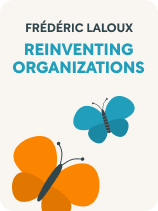

This article is an excerpt from the Shortform book guide to "Reinventing Organizations" by Frédéric Laloux. Shortform has the world's best summaries and analyses of books you should be reading.
Like this article? Sign up for a free trial here.
Would you like your company to put purpose above profit? Are you eager to lead self-directed employees?
In Reinventing Organizations, Frédéric Laloux identifies an emerging breed of company that operates from a new set of rules. These visionary organizations (“Teal companies”) embody principles of self-direction and individual authenticity while following a collective higher purpose.
Keep reading to learn how to create a Teal company of your own.
How to Create a Teal Company
Laloux concludes his book by suggesting ways that visionary concepts can take root in organizations. You can create a Teal company or transform your organization into one.
Once the necessary leadership is in place, you can set visionary practices in motion. Whether you’re starting a new company or steering one that already exists, Laloux suggests introducing workers to concepts of self-management, extolling the virtues of wholeness in the workplace, and embedding the company’s purpose into every aspect of work.
To do this, Laloux recommends you begin by educating all team members in the self-management practices the company will adopt. When members push back against these new ideas, reframe the conversation to talk about the positive assumptions about human nature that underlie self-management principles, such as that people are trustworthy, or that the best solutions often come from the front lines, not some lofty corporate office.
(Shortform note: Many of us may have trouble embracing Laloux’s positive outlook of human nature. However, in The Laws of Human Nature, Robert Greene argues that we sabotage ourselves by adopting irrational attitudes, such as holding onto needlessly negative views about ourselves and others. On the other hand, he explains that choosing positivity is empowering.)
The next components that Laloux says should be put in place are the advice process for making decisions, a method for conflict resolution, and tools for peer evaluation. In conjunction with this, leaders should implement safe space guidelines and provide training in collaboration and communication skills. From there, the organization can set a foundation to foster authenticity in the workplace and allow the company’s higher purpose to emerge.
(Shortform note: Showing up as your authentic self to work is a radical departure from the cultures many of us are used to. In Lean In, Facebook COO Sheryl Sandberg recommends delicate honesty when voicing your truth, but not hiding behind a professional persona. In The Coddling of the American Mind, Greg Lukianoff and Jonathan Haidt argue that safe spaces should not come at the cost of silence, and that diverse viewpoints must be honored.)
Companies based on an older paradigm will have to implement self-management gradually, with the full approval of the board and investors. Guiding an organization, or even one person, into a more elevated mindset is a twisting and bumpy process. However, Laloux contends that Teal companies represent the wave of the future and that adopting their practices now may better position modern-day companies to weather the changes of tomorrow.
(Shortform note: Business experts agree that implementing sweeping changes is difficult, yet worthwhile in the end. In Principles: Life and Work, Ray Dalio estimates that it can take up to 18 months for employees to adjust to new mindsets such as extreme transparency. In Good to Great, Jim Collins compares the process of transformation to driving a flywheel that requires a lot of effort to get going but eventually starts to spin on its own.)

———End of Preview———
Like what you just read? Read the rest of the world's best book summary and analysis of Frédéric Laloux's "Reinventing Organizations" at Shortform.
Here's what you'll find in our full Reinventing Organizations summary:
- The practices and values that are inherent in the next level of human organization
- A look at the paradigm shifts in organizational structure over the past 10,000 years
- How to implement visionary practices at your company






